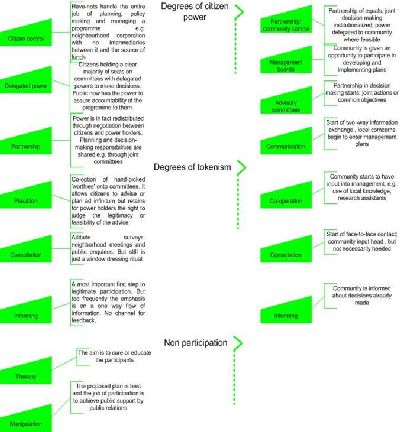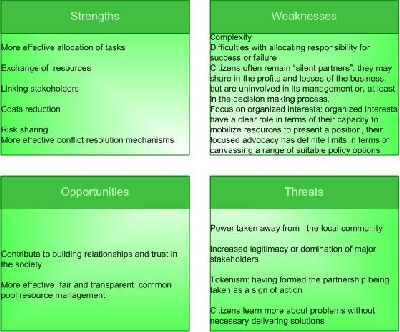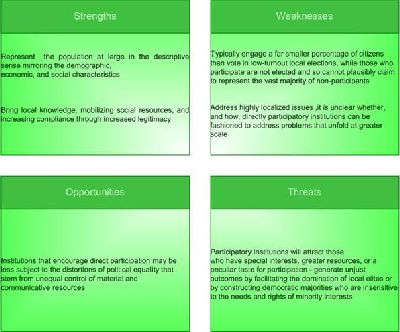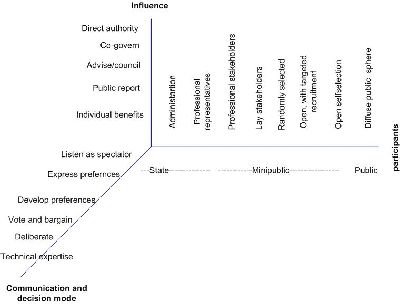Advocacy Democracy Modes: Benefits and Limitations
Marina Sokolova
Abstract
More and more often citizens and citizen groups directly interact with government, participate in the process of policy, although formation or administration, the actual and final decisions remain in the hands of government elites. Since these practices differ from representative and direct democracy mechanisms, some theorists argue that we witness emergence of a new "advocacy democracy". At the same time, however, advocacy democracy may exacerbate political inequality because of the inequality of usage: some citizens are empowered to become more involved in the democratic process, but other citizens who do not possess the skills or resources to compete in these new domains are left behind. In this context it is important to analyze three major modes of advocacy democracy - associations, multistakeholder partnerships and direct citizens' participation in the deliberative process, and to check them against the degree of citizen influence and citizen empowerment, as well as to discuss their benefits and limitations. The suggested analysis shows that all three participation modes should be considered as complimentary to each other. But when more common interests are threatened by the ecology of special interests or when accountability inducing reforms are unworkable, enhancing legitimacy, justice, or effectiveness may require circumventing the political grip of associations or major stakeholders by shifting the locus of decision-making to alternative participatory arrangements, such as direct citizens participation in deliberative process.
Administrative reforms, decentralization and other factors created new opportunities for access and influence, having improved the process of representative democracy in which citizens elect elites, and having generated new approaches to the forms of direct democracy that bypass (or compliment) democratic representative mechanisms. These changes resulted in expanding the participation repertoire through new legal rights that give citizen groups and individuals access to political information and influence that was seldom available to individual citizens or interest groups a generation ago. More and more often citizens and citizen groups directly interact with government, participate in the process of policy, although formation or administration, the actual and final decisions remain in the hands of government elites. Since these practices differ from representative and direct democracy mechanisms, some theorists argue that we witness emergence of a new "advocacy democracy" [Dalton et al., 2003].
Access and participation are key characteristics of advocacy democracy. Though, it was noted by some theorists that the terms are often confused (the former substituting the latter). Either "we have access with a desire that it be participatory," or we have subjects who are considered only as "users of communication, information networks and the media" [Pasquali, 2003: 214].
The present emphasis on access has several perverse effects:
- a growing ease of access makes participation more difficult and can inhibit it (and vice versa), generating more dependency, paternalism and social cybernetization, which explains the fact that the word "access" abounds in hierarchical business discourse, while participation scarcely appears;
- saturating the access function, to the point of dumping, discourages and inhibits any potential will to participate on the part of receivers;
- receiving others' knowledge and opinion without a counterpart can only institutionalize the muteness of the receiver/consumer.
As Pasquali writes, "there is no lack of experiments in raising the access threshold, measuring how much messaging the user can still take in. (Urban neighborhoods have been saturated with up to 500 television channels.) Meanwhile, a modest participatory project, such as a small, nearby television station managed by the community itself, would do what no overdose of access can ever do: improve relations, generate participation and promote genuine communication" [Pasquali, 2003: 215]. Pasquali warns against access hypertrophy, which can lead to serious participatory atrophy.
Public and/or citizen participation in policy-making, while always implicit, was made explicit in the declaration of the United Nations Conference on Environment and Development in 1992 [Rio Declaration on Environment and Development, 1992]. Since that declaration, governments worldwide have recognized the importance of public participation to ensure policy implementation.
But still there is no universal definition for citizen participation or widely accepted general theory of citizen participation. Citizens participation is often defined as a citizen action that influences or seeks to influence policy decisions [Nagel, 1987] or as an action that incorporates the demands and values of citizens into public administration services [Zimmerman, 1986]. Citizen participation can be classified into two categories 1) political participation such as voting in elections or getting involved in political proceedings; and 2) administrative participation such as demanding for or keeping a close watch on administrative operations.
We would suggest one more dimension for understanding of citizens' participation concept, defining it as participation in communicative planning by people who are not professional planners or government officials. Such participation may be realized in a number of modes (joining organized groups, through direct deliberative participation, referenda, ballots, involvement of representatives of NGOs in legislation and planning procedures, consensus conferences, mediation, round tables, advocacy planning, etc.).
In sum, advocacy democracy increases the potential for citizen access in important ways. It gives citizens and citizen groups new influence over the agenda-setting process and it can give the public unmediated participation in the policy process. At the same time, however, advocacy democracy may exacerbate political inequality because of the inequality of usage: some citizens are empowered to become more involved in the democratic process, but other citizens who do not possess the skills or resources to compete in these new domains are left behind [Dalton, 2003].
In this context it is important to analyze three major modes of advocacy democracy - associations, multistakeholder partnerships and direct citizens' participation in the deliberative process, and to check them against the degree of citizen influence and citizen empowerment, as well as to discuss their benefits and limitations.
Associations are internationally recognized as important participants in the strategies development and implementation processes. According to a recent study of 36 developed, developing and transitional countries, undertaken by the John Hopkin Comparative Nonprofit Sector Project, the civil society sector emerged as a important economic force with an expenditure of $ 1.3 trillion, equivalent to 5.4 percent of the combined GDP of the countries studied and a major employer (45.5 million full-time equivalent (FTE) workers) accounting for 4.4 percent of the economically active population [Ghaus-Pasha, 2004:3-6]. Associations offer additional channels for interest representation and public deliberation. They often become watchdogs to ensure government fulfillment commitments, and equalize representation, enable social coordination and empower individuals and communities by increasing their senses of efficacy, providing them with political information and political skills. At the same time associations are characterized by some weaknesses and deficits (see Fig 1 Associations SWOT)
Fig.1 Associations SWOT
[Source: Fung, 2003]
Multistakeholder partnerships
The ideas of multistakeholder partnerships are based on collaborative management paradigm. The latter is defined as "the sharing of power and responsibility between the government and local resource users," [Carlsson and Berkes, 2003:3]. The concept is that an agency with jurisdiction over an area (usually a state agency) might develop "a partnership with other relevant stakeholders (primarily including local residents and resource users) which specifies and guarantees their respective functions, rights and responsibilities with regard to the area" [Borrini-Feyerabend, 1996:8]. From the point of view of participation, the co-management paradigm is transformed into multistakeholder partnerships. And, if one regards the state as one among a set of stakeholders, a yet another definition of co-management may be proposed: "the sharing of responsibilities, rights and duties between the primary stakeholders, in particular local communities and the nation state; a decentralized approach to decision-making that involves the local users in the decision-making process as equals with the nation-state" [Soeftestad, 1999:11]. In 2002 the World Summit on Sustainable Development (WSSD) in Johannesburg marked the crowning of multistakeholder partnerships on the global policy scene.
The key characteristic of this participation mode is that the partners aim to achieve something they could not do alone, by pooling skills and other resources [Wilcox, 1994]. To do this they need a shared vision of their goals, and a way of working together which realizes this ambition, i.e. they need "multistakeholder processes" which
- aim to bring together all major stakeholders in a new form of communication, decision-finding (and possibly decision-making) structure on a particular issue;
- are based on recognition of the importance of achieving equity and accountability in communication between stakeholders;
- involve equitable representation of three or more stakeholder groups and their views;
- are based on democratic principles of transparency and participation;
- aim to develop partnerships and strengthened networks between and among stakeholders
Thus, a "multistakeholder process" becomes a version of co-management, and the Arnstein's ladder of participation is redesigned (See Fig.2 Ladder of citizens' participation)
Fig.2 Ladder of citizens participation
[Sources: Arnstein, 1969; Berkes, 1991]
The benefits of multistakeholder partnerships are obvious in the areas of allocation of tasks, exchange of resources, linking different levels of organization and cross linkages. Such partnerships could reduce transaction costs, spread the risk among involved parties, and implement more effective conflict resolution mechanisms. And, which is perhaps more important, multistakeholder partnerships contribute to building relationships and trust in the society. However before suggesting multistakeholder partnership as a general remedy for various common-pool resources problems one must carefully consider its limitations, particularly regarding the issue of public participation.
First of all, as Carlsson and Berkes argue, "one must ask if the call for co-management is caused by the fact that power has been taken away from the local community in the first place" [Carlsson, Berkes, 2003:11]. To offer a co-management agreement (or a multistakeholder partnership), they continue, might as well be an attempt of state authorities (or international bodies) to increase the legitimacy of their domination, or a means of codifying an existing situation, or it might be an attempt by the state to offload a regulatory function too costly to manage [Carlsson, Berkes, 2003:11]. The complexity of multistakeholder partnerships may entail more challenges.
Fig. 3. Multistakeholder partnerships complexity

[Source: Carlsson, Berkes, 2003:7]
As D. Mackie points out, even small authorities or associations may be involved in dozens of partnerships, covering diverse matters. It becomes more and more difficult to track the delivery record of such a system and allocate responsibility for success or failure. Many partnerships have become talking shops, the mere fact of having formed the partnership being taken as a sign of action [Mackie, 2000]. In the event that a "multistakeholder process" is not transformed into collaborative management, citizens learn more about problems without necessary delivering solutions. Lack of communication in some cases and one partner's domination in others, generate hidden agendas and manipulation during multistakeholder processes. In addition, financial and time commitments may outweigh potential benefits [Wilcox, 1994]. As the result citizens often remain "silent partners": they may share in the profits and losses of the business, but are uninvolved in its management or, at least in the decision making process.
In practice, relations between citizens and major stakeholders (governments, businesses and NGOs) as policy makers are in some cases limited to formal exchanges. The latter make available or deliver information to citizens who at best receive it in a one-sided exchange. Less frequently, citizens are invited to offer their views as part of a 'consultation' exercise. In relation to national issues, this is usually done through a formal inquiry in which, for instance, government sets the agenda and provides the background information and citizens are invited to make formal submissions. Besides, while organized interests have a clear role in terms of their capacity to mobilize resources to present a position, their focused advocacy has definite limits in terms of canvassing a range of suitable policy options [Curtain, 2003].
Fig.4 Multistakeholder partnerships SWOT
[Source: Carlsson, Berkes, 2003]
Direct citizens participation in deliberative process
When more common interests are threatened by the ecology of special interests or when accountability inducing reforms are unworkable, enhancing legitimacy, justice, or effectiveness may require circumventing the political grip of associations or major stakeholders by shifting the locus of decision-making to alternative participatory arrangements [Fung, 2003].
Engaging ordinary citizens in deliberations about the operations of government can increase legitimacy, bring crucial local knowledge to bear on public action, add resources, and enhance public accountability. But experience reveals some critical concerns about direct deliberation:
- the democratic character of processes and outcomes may be vulnerable to serious problems of power and domination inside deliberative arenas by powerful factions or elites;
- external actors and institutional contexts may impose severe limitations on the scope of deliberative decision and action. In particular, powerful participants may engage in "forum shopping" strategies in which they use deliberative institutions only when it suits them;
- these special-purpose political institutions may fall prey to rent seeking and capture by especially well-informed or interested parties;
- the devolutionary elements of direct deliberation may balkanize the polity and political decision making;
- empowered deliberation may demand unrealistically high levels of popular participation, especially in contemporary climates of civic and political disengagement;
- these experiments may enjoy initial successes but may be difficult to sustain over the long term [Fung 2003,2004] (See Fig 5 Deliberative citizens participation SWOT)
Fig. 5 Deliberative citizens participation SWOT
[Sources: Fung, 2003, 2005]
In modern world hundreds of deliberations evolve outside government or might deal with government policies, programs and issues but discuss them in the context of the forum in which they are participating. It is critical for new and old democracies to make them effective and influential participation practices. Institutialization of direct citizens deliberation should be based on clear understanding of strategies, tactics, principles and results of the process (see Fig.6. Direct citizens deliberation. Basic principles)
Fig. 6. Direct citizens deliberation. Basic principles
|
[Source: Fung, 2003]
Within the framework of citizens participation in deliberative process, the ladder of participations transforms into a "democracy cube", where citizens as participants form a clearly defined minipublic (see Fig.7. Democracy cube)
Fig.7 Democracy cube
[Source: Fung, 2005]
New communication tools are to be used as channels for participation and consultations from the citizenry. This meant not just relying on one specific tool, such as using the Internet and wireless technologies, but including television, radio and whatever tools might work to facilitate the process. Governments putting online their legislation, legislative proposals and background documents on issues may be a start towards bringing more citizens into the process. But it is still very much a top-down approach by government. As an analysis shows that the groups and individuals engaged in e-democracy mainly rely on the agenda set by government and react to what government is doing to create input. [Riley B., Riley C., 2003]. At the same time there are individuals and organizations outside governments engaged in recruiting "minipublics" or in developing online communities of e-democracy participants. Among them, two major approaches are popular, according to Riley. The first one is to build a community of networks in which people can engage themselves in political discourse, develop ways to input into government policy and decision-making, and recommend ways to use technology to be able to influence the process of government. The other approach is a more traditional one, i.e. working with governments from an academic institution to develop tools to help legislators and administrators obtain public input on issues of the day. Both approaches were tested in Lithuania, and their efficiency was acknowledged by the society.
Conclusion
The above discussion of direct citizen participation in deliberative process and of associations' and multistakeholder partnerships' input shows that they should be considered as complimentary to each other. Direct participation can make the leaders and agendas of interest groups, and other associations more responsive and accountable to the interests of members and constituents. When more common interests are threatened by the ecology of special interests or when accountability inducing reforms are unworkable, enhancing legitimacy, justice, or effectiveness may require circumventing the political grip of associations or major stakeholders by shifting the locus of decision-making to alternative participatory arrangements, such as direct citizens participation in deliberative process [Fung, 2003].
Deliberative citizens participation is often initiated either by state, or by CSOs, or emerges as the result of partnership between non-profit organizations and government officials or legislators thus enhancing legitimacy and justice of multistakeholder processes. The groups of players who are engaging citizens from around the world in wide debate are an important part of the changing nature of democracy. This continues to be a fluid subject and the role of outside groups is an important phenomenon of which governments are beginning to take cognizance. These emerging groups, and individuals, increasingly see themselves as partners in the process of democracy not necessarily part of the elected bodies or government [Riley, 2003].
In this light public servants need to learn to consult the public; elected officials should facilitate engagement, overview experimentation in new ways to obtain public input, and both renew and ensure accountability. These trends are vital for effective democracy, for building social capital and knowledge society, as well as for building trust in state machinery and social cohesion enhancing. Seeking to find an interactive role for the citizen in an effective and meaningful way is one of the major challenges now facing both governments and CSOs.
Bibliography
Arnstein, Sherry R. A Ladder of Citizen Participation Journal of the American Planning Association, 35 (4):1969: 216-224
Berkes, F., Preston R., Co-management: the Evolution of the Theory and Practice of Joint Administration of Living Resources. Alternatives, 18 (2):1991:12-18
Borrini-Feyerabend, G. Collaborative management of protected areas: Tailoring the Approach to the Content.http://www.iucn.org/themes/spg/Tailor/index.html (09. 01. 2004).
Carlsson L., Berkes, F. Co-management across levels of organization: concepts and methodological implications. Lead paper prepared for the Resilience panel and the Regional Workshop of the International Association for the Study of Common Property, "Politics of the Commons: Articulating Development and Strengthening local practices, Chiang Mai, Thailand, July 11-14, 2003. http://dlc.dlib.indiana.edu/archive/00001133/00Lars_Carlsson.pdf (20.09.2005).
Curtain R., What Role for Citizens in Developing and Implementing Public Policy? Part 1 Canberra Bulletin of Public Administration, June 5, 2003. http://www.apprn.org/pdf/Curtain_CitizenEngagementPart1.pdf (20.09.2005).
Dalton Russell J., Scarrow Susan E., and Cain Bruce E., Democracy Transformed?: Expanding Political Opportunities in Advanced Industrial Democracies. Center for the Study of Democracy. Paper 03-04. 2003. http://repositories.cdlib.org/csd/03-04 (20.09.2005).
Fung, A., Recipes for Public Spheres: Eight Institutional Design Choices and Their Consequences Journal of Political Philosophy, 11 (3): 2003: 338-67.
Fung, A. Varieties of Participation in Complex Governance. 2005. www.archonfung.net/papers/FungVarietiesOfPart.pdf (20.09.2005).
Ghaus-Pasha A., Role Of Civil Society Organizations In Governance. 6th Global Forum on Reinventing Government Towards Participatory and Transparent Governance 24 - 27 May 2005, Seoul, Republic of Korea http://unpan1.un.org/intradoc/groups/public/documents/un/unpan019594.pdf (20.09.2005).
Hemmati, Minu. Multi-stakeholder processes for governance and sustainability. London, Earthscan Publications Ltd., 2002
Mackie, D. Dancing while Standing Still. 2000 http://www.partnerships.org.uk/articles/still.htm (20.09.2005).
Nagel, Jack. Participation. Englewood Clifs, NJ: Prentice Hall. 1987
Pasquali A. A Brief Descriptive Glossary of Communication and Information (Aimed at Providing Clarification and Improving Mutual Understanding) in Bruce G. and O Siochru S. Communicating in the Information Society, Geneva, UNRISD, 2003 http://files.crisinfo.org/cris/pasquali.pdf (25.07.2005).
Riley Thomas B., Riley Cathia G. E-Governance to E-democracy: Examining the Evolution. International Tracking Survey Report '03 N 5. 2003. www.electronicgov.net/pubs/research_papers/ tracking03/IntlTrackRptJune03no5.pdf (25.07.2005).
Soeftestad L. The International Workshop on Community- Based natural Resource Management (CBNRM), Washington D.C., 10-14 May 1998. Workshop Report. Washington D.C: World Bank http://www.cbnrm.net/pdf/soeftestad_l_001_98wbreport.pdf (21.09.2005).
The Rio Declaration. Report of the United Nations Conference on Environment and Development. Rio de Janeiro, 3-14 June 1992. Annex 1. Rio Declaration on Environment and Development. 1992. http://www.sovereignty.net/p/sd/riodec1.htm (21.09.2005).
Wilcox D. The Guide to Effective Participation. Brighton, UK, Partnership Books, 1994 www.partnerships.org.uk/guide/index.htm (21.09.2005).
Zimmerman, J. Populism revisited. State Government, V. 58, 1986: p. 172-178.
This information may be reproduced provided that E-Belarus.org is given as the source.
E-Belarus.ORG, 2001-2015

This
work is licensed under a
Creative Commons Attribution-Noncommercial-No Derivative Works 3.0 License




